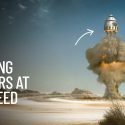What would our world look like without running water? You go to pour yourself a drink, but nothing comes out of the tap. You can’t shower, grow your crops, or even wash your hands. How long could you last without it?
In the U.S., people use 303 to 379 liters (80 to 100 gal) of water per person each day. That’s over 121,000 liters (32,000 gal) per person each year. About 60% of an average adult human body is water. And on average, you need to consume 2.7 to 3.7 liters (91-125 oz) of water from food and beverages each day. But what could you do to quench your thirst when your faucet has run dry?
How can a straw help? Would it help to live by a lake? Should you drink rainwater? Today, nearly 800 million people worldwide lack basic access to clean water. And about 17 countries, with one-quarter of the world’s population, face extremely high levels of baseline water stress. This means that every year, irrigated agriculture, industries, and municipalities withdraw more than 80%, on average, of their available water supply. And people are worried about running out of water. While you may not live in one of those countries, you can understand what it’s like to go without water. So, what should you do when the well runs dry?
Step 1. Know What’s Potable
If the tap is dry, you need to use whatever water is available. There are two types of water, potable and non-potable. In many countries, potable water is the water that flows out of your taps,
including your kitchen and bathroom sinks, showers, and bathtubs. This water is often clean and safe because a municipal water treatment plant treated it before it flowed out of your pipes.
But this is not the case in every country. Or, you may buy potable water, such as bottled water. Non-potable water can come from a variety of sources, including lakes, streams, and rainwater.
This water is not usually safe to cook with or drink unless you purify it. But sometimes you can use it for washing your clothes or cleaning your house. So, always know if your water is potable or not.
Step 2. Make It Safe
You can boil water to purify it in an emergency. If water is cloudy, or you see debris or other things in the water, let it settle. Then filter it through a towel, coffee strainer, or a clean cloth. Or, you can use a water purifier jug, but it won’t help with heavy metals and poisons. Then, bring the water to a rolling boil for at least one minute. At altitudes above 1,500 m (5,000 ft), boil the water for three minutes. You can also buy special straws that purify water. Chlorine bleach and iodine drops are other ways you can purify water.
Step 3. Look for Bottled Water
If you prepared for an emergency, you might have some bottled water to sustain you until your usual water supply returns. In 2014, the U.S. city of Flint switched its drinking water supply from Detroit’s water system to the Flint River to save money. But the water wasn’t potable. While the taps were not running dry, many people had to switch to bottled water for bathing, drinking,
and most tasks that need water. Flint’s water quality has improved slightly since then, but it’s still not safe to consume.
Step 4: Be Aware of Water Shut-offs
If you live in the United States, you know that water shut-offs can occur. There are more than 151,000 public drinking water systems across the United States, run by municipalities, regional collectives, and private companies. Each is subject to state and local laws. This means that local leaders and the people running the private companies can shut off the water system.
And often, if someone can’t pay their water bill, gas and other utilities are also shut off, making it hard to boil other water.
Step 5: Purify Rainwater
If you don’t have potable water, you may be able to collect rainwater if your area allows it. But be careful. According to the Centers for Disease Control and Prevention, you should not assume that rainwater is safe to drink. Dust, smoke, and pollution could be in the water. If you collect water from a roof, it could be contaminated with lead, asbestos, dirt, and germs. And rain barrels don’t treat or filter your water to make sure it’s potable. Boiling the water long enough will kill any germs in it, but it does not remove chemicals. Sometimes you can see unusual colors or smell chemicals in the water, but not always. Even Earth’s huge oceans contain pollution from oil spills, garbage, and other causes.
Sources
- Some Towns Still Haven’t Halted Utility Shut-offs for Unpaid Water Bills During Coronavirus, Even as Federal Lawmakers Demand It. Buford, T. and Campbell, S. (2020). Propublica.
- How Many Countries Don’t Have Clean Water? Top 10 List and Facts. (2020); Lifewater.
- 17 Countries, Home to One-Quarter of the World’s Population, Face Extremely High Water Stress. Hofste, R. W., Reig, P. and Schleifer, L. (2019). World Resources Institute.
- How Does a Flood-prone City Run Out of Water? Inside Chennai’s “Day Zero” Crisis. Palanichamy, R. B. (2019). World Resources Institute.
- 3 Things Cities Can Learn from Cape Town’s Impending “Day Zero” Water Shut-Off. Otto, B. and Schleifer, L. (2018). World Resources Institute.

















